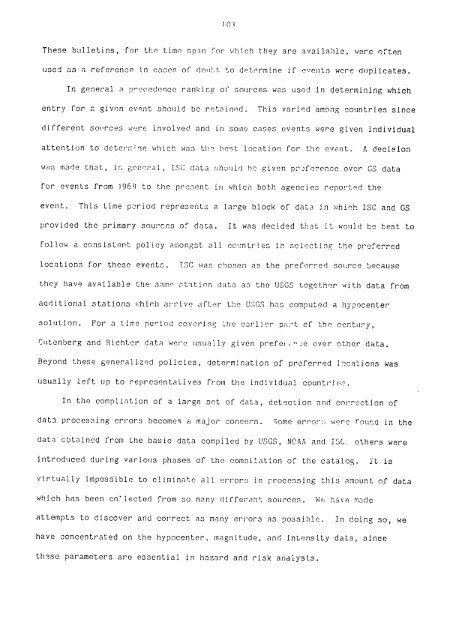catalogo de terremotos para america del sur catalog of earthquakes ...
catalogo de terremotos para america del sur catalog of earthquakes ...
catalogo de terremotos para america del sur catalog of earthquakes ...
You also want an ePaper? Increase the reach of your titles
YUMPU automatically turns print PDFs into web optimized ePapers that Google loves.
S03<br />
These bulletins, for the time span for which they are available, were <strong>of</strong>ten<br />
used as a reference in cases <strong>of</strong>A do,:Lt to <strong>de</strong>terrinne if events were duplicates.<br />
In general a p-ece<strong>de</strong>nce ranking oK sources was used in <strong>de</strong>termining which<br />
entry for a given event should be retained. This varied among countries since<br />
different sources were involved and in some cases events were given individual<br />
attention to <strong>de</strong>termine which was the best location for the event. A <strong>de</strong>cision<br />
was ma<strong>de</strong> that, in general, IS data should be given preference over GS data<br />
for events from 1964 to the present in which both agencies reported the<br />
event. This time period represents a large block <strong>of</strong> data In which ISC and GS<br />
provi<strong>de</strong>d the primary sources <strong>of</strong> dana. It was <strong>de</strong>ci<strong>de</strong>d that it would be best to<br />
follow a consistent policy amongst all comntries in selecting the preferred<br />
locations for these events. TSC was chosen as the preferred source because<br />
they have available the samo wt-tion data as the USGS together with data from<br />
aaditional stations which arrive after the USGS has computed a hypocenter<br />
solution. For a time period covering 4he earlier pa;'t f the century,<br />
Cutenberg and Richter data were usually given prefer,-'e over other data.<br />
Beyond these generalized policies, <strong>de</strong>termination <strong>of</strong> preferred locations was<br />
usually left up to representatives from the individual countriew.<br />
In the compilation <strong>of</strong> a large set <strong>of</strong> data, <strong>de</strong>tection and correction <strong>of</strong><br />
data processing errors becomes a major concern. Some errors, were round in the<br />
data obtained from the basic data compiled by USGS, NOAA and MSG; others were<br />
Introduced during various phases <strong>of</strong> the comnilation <strong>of</strong> the <strong>catalog</strong>. it is<br />
virtually impossible to eliminate all errors in Frocessing this amount <strong>of</strong> data<br />
which has been colected from so many different sources. We have ma<strong>de</strong><br />
attempts to discover and correct as many errors as possible. In doing so, we<br />
have concentrated on the hypocenter, magnitu<strong>de</strong>, and intensity data, since<br />
these <strong>para</strong>meters are essential in hazard and risk analysis.

















